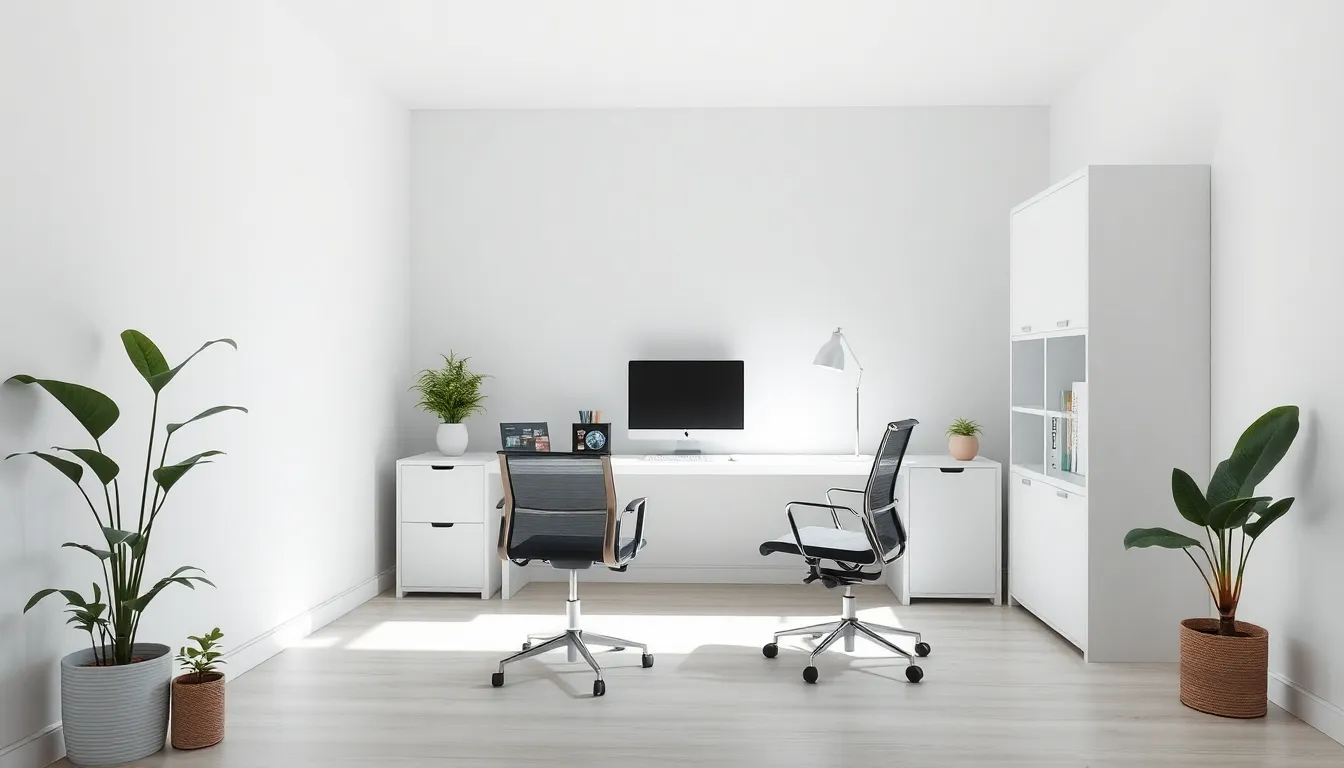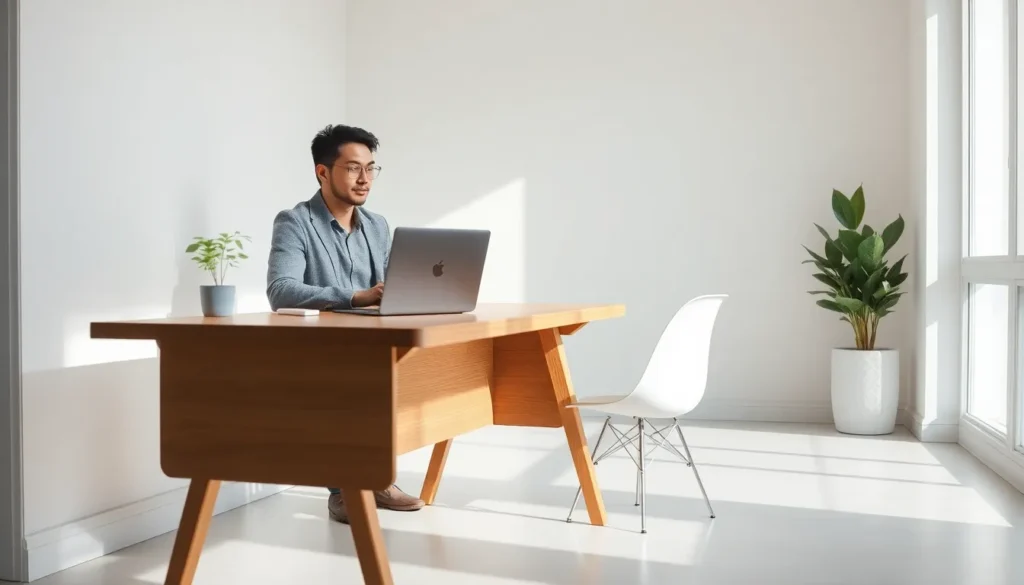Table of Contents
ToggleIn today’s fast-paced world, the clutter of modern life can feel overwhelming. Minimalist workspaces emerge as a refreshing antidote, promoting clarity and focus amid chaos. By stripping away distractions, these thoughtfully designed environments foster creativity and productivity, allowing individuals to thrive.
Embracing simplicity doesn’t just enhance aesthetics; it cultivates a mindset geared toward efficiency and mindfulness. As more people recognize the benefits of a minimalist approach, they discover how a clean and organized workspace can lead to improved well-being and enhanced performance. Whether working from home or in a corporate setting, adopting a minimalist workspace can transform the way one works and thinks.
What Are Minimalist Workspaces?
Minimalist workspaces emphasize simplicity and functionality. They create environments that promote focus and enhance productivity.
Key Features of Minimalist Design
- Uncluttered Surfaces: Minimalist designs prioritize clear surfaces, reducing distractions.
- Neutral Colors: Often characterized by whites, grays, and earthy tones, these colors foster calm and concentration.
- Functional Furniture: Furniture serves specific purposes without unnecessary embellishments, maximizing utility.
- Natural Light: Minimalist workspaces leverage natural light to improve mood and efficiency.
- Limited Decorations: Artwork and personal items remain minimal, ensuring attention on work tasks.
Benefits of Minimalist Workspaces
- Enhanced Focus: Reduced clutter leads to fewer distractions, improving concentration on tasks.
- Increased Productivity: A streamlined environment fosters quicker decision-making and task completion.
- Stress Reduction: Simplicity contributes to a calming atmosphere, lowering stress levels.
- Better Organization: Minimalist spaces promote efficient organization, making tools and information easy to find.
- Support for Creativity: A clear workspace enhances creative thought processes, encouraging innovative ideas.
Designing Your Minimalist Workspace

Designing a minimalist workspace involves careful selection of elements that enhance functionality and promote a serene environment. Focusing on simplicity ensures a more productive and mindful work experience.
Choosing the Right Furniture
Choosing the right furniture is crucial for a minimalist workspace. Select functional pieces that serve multiple purposes, such as desks with built-in storage or ergonomic chairs enhancing comfort and support. Opt for sleek lines and a modern design to maintain an uncluttered aesthetic. Prioritize quality over quantity; investing in fewer, high-quality items benefits longevity and reduces unnecessary distractions.
Color Palette and Decor
Color palette and decor significantly impact a minimalist workspace. Use neutral colors like white, gray, or beige to foster tranquility and focus. Incorporate subtle accents in muted tones for visual interest without overwhelming the senses. Choose a few essential decorative items, such as plants or artwork, to personalize the space while retaining an airy feel. Maintain a consistent theme throughout to promote cohesion and clarity in the workspace environment.
Maintaining a Minimalist Workspace
Maintaining a minimalist workspace requires ongoing effort and intentional practices. Utilizing effective decluttering strategies and daily practices ensures the workspace remains efficient and serene.
Decluttering Strategies
- Set a Schedule: Designate specific times each week or month for decluttering. Regular intervals prevent accumulation of unnecessary items.
- Categorize Items: Group similar items together to identify redundancies. This process highlights which items are essential and which can be removed.
- Implement the One-In, One-Out Rule: For every new item added, remove an existing item. This strategy keeps the workspace from becoming overcrowded.
- Use Storage Solutions: Utilize organizers, baskets, or drawers to store items out of sight. Effective storage maintains a clean appearance and improves access to essential tools.
- Digitize Files: Convert physical documents into digital formats. Reducing paper clutter minimizes distractions and streamlines organization.
Daily Practices for Minimalism
- Prioritize Daily Tasks: Begin each day by outlining key tasks. Focusing on priorities reduces the temptation to clutter the workspace with non-essential materials.
- Limit Desktop Items: Keep only the most necessary tools on the desk. Removing all but essential items fosters concentration and clarity.
- Practice Mindful Consumption: Be intentional with new purchases. Consider functionality and necessity before acquiring additional items for the workspace.
- End-of-Day Clean-Up: Take a few minutes at the end of each day to tidy the workspace. Regular clean-up reinforces minimalist habits and mental clarity.
- Reflect on Workspace Needs: Periodically evaluate the workspace’s design and functionality. Reassess items and arrangements to ensure continued alignment with minimalist values.
Case Studies of Successful Minimalist Workspaces
Various case studies illustrate the effectiveness of minimalist workspaces in enhancing productivity and well-being. Below are examples focusing on home offices and corporate environments.
Home Offices
Home offices benefit significantly from minimalist design principles. For instance, a case study of a remote worker in San Francisco shows a workspace featuring a single desk, two functional stools, and a few selected plants. The individual utilizes a neutral color scheme, ensuring a clean and serene atmosphere that promotes focus. Clear surfaces accommodate only essential items, such as a laptop and a notepad, allowing for maximum concentration on tasks.
Another example involves a freelancer in New York City. The workspace incorporates smart storage solutions, like a wall-mounted shelving unit and hidden compartments, effectively reducing visible clutter. Minimal decorative elements, such as a framed piece of art and a small succulent, enhance the aesthetic while avoiding distractions. This setup results in increased creative output and greater satisfaction with work-life balance.
Corporate Environments
In corporate environments, minimalist workspaces streamline operations and foster collaboration. A notable case is a tech company in Seattle that adopted an open-plan minimalist design. The office features modular furniture that facilitates reconfiguration based on team needs, promoting adaptability and teamwork. Uncluttered workstations ensure employees maintain a focused environment, supporting efficiency and innovation.
Another example can be seen at a financial firm in Chicago, where the design emphasizes natural light. Large windows and open spaces contribute to an airy feel. Employees utilize multi-functional furniture like standing desks that cater to ergonomic needs while reinforcing a clean aesthetic. Feedback indicates that the minimalist changes led to increased employee satisfaction and improved performance metrics across departments.
Embracing a minimalist workspace can transform the way individuals approach their daily tasks. By prioritizing simplicity and functionality, these environments not only enhance productivity but also promote a sense of calm and clarity. The intentional design choices reflect a commitment to efficiency and mindfulness that can lead to improved well-being.
As more people adopt minimalist principles, they discover that a clean and organized workspace fosters creativity and focus. Whether in a home office or a corporate setting, the benefits of minimalism are clear. It’s about creating a space that supports one’s goals while minimizing distractions, ultimately paving the way for a more effective and enjoyable work experience.







